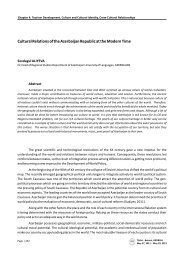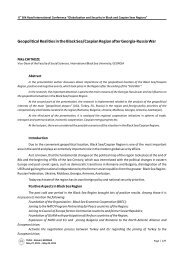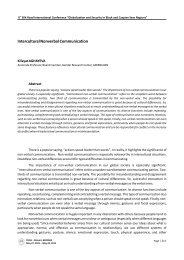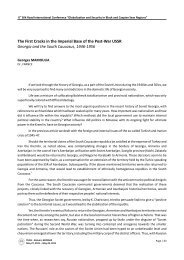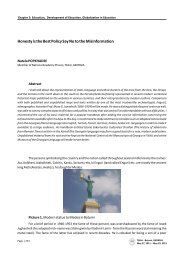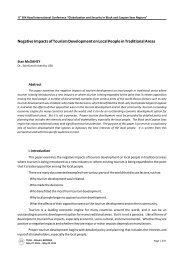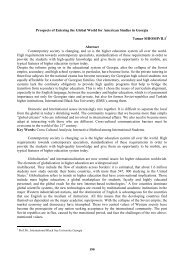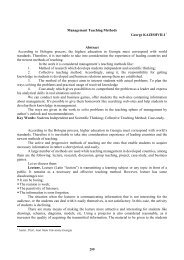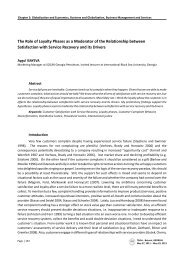Comparative Student Life Style Analysis of a Private University ...
Comparative Student Life Style Analysis of a Private University ...
Comparative Student Life Style Analysis of a Private University ...
Create successful ePaper yourself
Turn your PDF publications into a flip-book with our unique Google optimized e-Paper software.
<strong>Comparative</strong> <strong>Student</strong> <strong>Life</strong> <strong>Style</strong> <strong>Analysis</strong> <strong>of</strong> a <strong>Private</strong> <strong>University</strong><br />
Ibrahim KELESH *<br />
Abstract<br />
A consumer lifestyles study was conducted at a private university in Bishkek, Kyrgyzstan.<br />
Some activities, interest and opinions (AIO) and Values, Attitudes, and <strong>Life</strong>style (VALS)<br />
statements were obtained from marketing literature, and Stanford Research Institute Consulting<br />
Business Intelligence Research Programs (SRIC-BI) were used to identify lifestyle indicators <strong>of</strong><br />
target groups.<br />
Key words: <strong>Life</strong>style, VALS, Kyrgyzstan, higher education<br />
1. Introduction<br />
The buying behaviour <strong>of</strong> the consumer is a quite complex process. This complex process<br />
forces the consumer to develop a style. This style explains the attitudes <strong>of</strong> the consumer’s<br />
behaviours on buying decisions. The values, which are one <strong>of</strong> the most important sources leading<br />
the behaviours <strong>of</strong> the individual in all life periods and dimensions, shape his daily life. Furthermore,<br />
these values establish the decision-making process <strong>of</strong> the consumer. Because <strong>of</strong> these properties,<br />
values and life styles are stated as important variables which affect consumer behaviour (Ü nal &<br />
Erciş, 2006).<br />
Psychographics is the science <strong>of</strong> using psychology and demographics to better understand<br />
consumers (Kotler, 2003). It groups customers based on their attitudes, values and lifestyle. The<br />
latter may be defined as the consumer behaviour which the target group displays, and the values and<br />
attitudes, which lead to this particular behaviour (Keegan & Schlegenmilch, 2001).<br />
<strong>Life</strong>style is people’s decisions about how to live their daily lives, including family, job,<br />
social, and consumer activities (Boone & Kurtz, 1998). As life styles <strong>of</strong>fer a more comprehensive<br />
view <strong>of</strong> behaviour and the motivations that underlie many <strong>of</strong> the purchases made by consumers,<br />
they are regarded as advantageous for market segmentation.<br />
This is particularly so when comparing them to demographic bases for segmentation, which is still<br />
the most commonly applied method (Todd et al).<br />
Generally speaking, VALS is one <strong>of</strong> the most popular tools used in life style studies. VALS<br />
method was developed by SRIC-BI. SRIC-BI conducted a survey <strong>of</strong> over 1600 randomly selected<br />
American consumers in 1983. More than 800 questions <strong>of</strong> survey about attitudes, spending,<br />
earnings, media habits, product consumption, and activities were asked. Based on the results <strong>of</strong> the<br />
survey, a typology <strong>of</strong> American consumers, called VALS, was created. The VALS method provides<br />
a typology <strong>of</strong> three basic categories <strong>of</strong> consumers’ values and lifestyles, with nine defined types<br />
(Mitchell 1983).<br />
Consequently, SRIC-BI published a second version called VALS II. It divides Americans<br />
into eight segments on the basis <strong>of</strong> their self-identity orientations and their wealth (Kwon et al,<br />
1999).<br />
2. Study Objective<br />
* Ph.D. Candidate, International Atatürk Alatoo <strong>University</strong>.Kyrgyzstan<br />
304
In this cross national/cultural study, lifestyles <strong>of</strong> local students and international students<br />
were identified and compared. Nearly one hundred thousand, %10 <strong>of</strong> city population, university<br />
students are there in the city. Also totally in Kyrgyzstan, there are 200.000 university students and<br />
20.000 <strong>of</strong> them are international students (Osmanaliev, 2006). This number forces us to focus on<br />
this market. Identifying and comparing these consumer groups would help marketing people to<br />
create appropriate marketing strategies. This study aims to make a contribution as a first step for<br />
them.<br />
3. Methodology<br />
Bishkek is the capital city <strong>of</strong> Kyrgyzstan, with a population <strong>of</strong> one million. Despite this<br />
population number, there are more than thirty higher education institutes, and also, living costs are<br />
cheap in the city. This makes city a “free education market.” The current situation attracts<br />
international students to study in Bishkek. Additionally, as a result <strong>of</strong> the ex-USSR system, there is<br />
a diversity <strong>of</strong> nationalities in the city that makes the student demographics <strong>of</strong> universities like a<br />
rainbow. This multinational environment forms a field study area for comparing life styles <strong>of</strong><br />
different nations and cultures. In this study, citizens <strong>of</strong> Republic <strong>of</strong> Kyrgyzstan are referred to as<br />
“local students.” All other students are referred as “international students”.<br />
The data for this study was collected at a private university in Bishkek, Kyrgyzstan,<br />
International Atatürk Alatoo <strong>University</strong> (IAAU) during December <strong>of</strong> 2006. It has a total population<br />
<strong>of</strong> 886, with 12%, international students from neighbour countries like China, Tajikistan,<br />
Kazakhstan, and other countries like Russian Federation, Turkey, Nigeria, etc (IAAU web page,<br />
Sagbansua and Keles 2006). Table 8.1 represents the student pr<strong>of</strong>ile <strong>of</strong> International Ataturk Alatoo<br />
<strong>University</strong><br />
The survey consisted <strong>of</strong> two sections. The first section was based on Erdener Kaynak’s<br />
survey. He conducted this survey for cross national/cultural life style analyses sucessfully with<br />
American, Canadian (2004), Kyrgyz and Azeri consumers (2001). So that, this survey is a suitable<br />
tool for analysing cross national/cultural lifestyles <strong>of</strong> consumers like IAAU students. Of course,<br />
some modifications were done. For example, the original survey had some questions directed to<br />
housewives. But nearly all students <strong>of</strong> IAAU are single. Instead <strong>of</strong> those questions, some AIO and<br />
VALS statements were obtained from marketing literature, and SRIC-BI were used to identify lifestyle<br />
indicators <strong>of</strong> IAAU students (Kwon et al 1999, Kaynak and Kara 2001, Harcar et al 2004,<br />
SRIC-BI 2006). The question regarding credit cards was omitted, because credit cards were not in<br />
service at that time, although now there are more than thirty thousand credit card users in<br />
Kyrgystan.<br />
The second section <strong>of</strong> the survey consists <strong>of</strong> questions for identifying demographic and<br />
socio-economic characteristics.<br />
Totally, there are 56 AIO and VALS statements for identifying life styles, and 5 questions<br />
for identifying demographic and socio-economic characteristics in the survey.<br />
A five-point Likert scale was used, “1” being “strongly disagree” and “5” being “strongly<br />
agree.”<br />
Previously, the survey was used in Kyrgyzstan successfully, so that a pre-test was not made.<br />
The data used for this research was collected through class visits. Randomly, some <strong>of</strong> the<br />
classes were visited; surveys distributed to students, and in approximately in twenty minutes they<br />
gave surveys back. 250 surveys were distributed, yet due to incompleteness, only 228 usable<br />
305
questionnaires were obtained. Table 8.2 shows demographic and socio-economic characteristics <strong>of</strong><br />
the students responding to the survey.<br />
4. RESULTS<br />
To understand the differences and similarities between local and international students’<br />
purchasing and consumption related behaviours, means on respondents’ reactions to survey<br />
questions were compared. Table 8.3 shows that there are statistical differences between local and<br />
international students’ lifestyles. The major differences between the two groups <strong>of</strong> students are<br />
shown below.<br />
Local students think that they will be in a better economic condition in the future. In this<br />
area, the greatest variance between local and international students occurs. But anyway both<br />
students groups are “Economically Conscious”. They have similar levels. Perhaps this is the result<br />
<strong>of</strong> being student.<br />
Local students have a greater willingness to spend a year in a foreign country. Surprisingly,<br />
they also define themselves as homebodies. Perhaps they want to go abroad, but temporarily. They<br />
want to come home again. Paradoxically, international students have a lower level <strong>of</strong> willingness to<br />
go abroad. They are already abroad. They also don’t define themselves as homebodies. Perhaps<br />
they miss their homes.<br />
Local students have more optimistic opinions than their foreign counterparts. But credit<br />
cards are somewhat unfamiliar local students. It is a new payment tool for the country. Also,<br />
international students don’t like to pay cash everything they buy. Perhaps they have some habits<br />
like credit cards or credit sales in their home countries.<br />
In comparing all lifestyle types, local students got higher points except for being “fashion<br />
oriented”. International students placed more importance on the latest hairstyles and dressing<br />
smartly.<br />
Local students gave importance to family than the international students. Additionally, they<br />
give more importance to house cleaning. Both <strong>of</strong> the groups have similar grades for seeing their life<br />
as a definite routine. And both students groups gave equal importance to the advice <strong>of</strong> their friends<br />
regarding which brand to buy.<br />
Monthly spending levels <strong>of</strong> local students are approximately 2500 KG Som (65.8 US $) and<br />
international students spend more than 3438 KG Som (90.5 US $). International students are<br />
spending 28% more than their counterparts.<br />
5. Conclusions And Implications<br />
Consumer lifestyle analysis provides a greater understanding <strong>of</strong> consumers’ buying and<br />
consumption behaviors. Also, in a university, the students (consumers) must be satisfied. Nearly<br />
one hundred thousand, 10% <strong>of</strong> cities population, are university students. iIn Kyrgyzstan, there are<br />
200.000 university students, and 20.000 <strong>of</strong> them are international students (Osmanaliev, 2006). This<br />
number forces to focus on this market. Identifying and comparing these consumer groups would<br />
help marketing people to create appropriate marketing strategies. In addition, multinational<br />
environments are hard places to manage. These studies can be used to identify common points<br />
among local and international students and also differentiate points. This study may be a helpful<br />
tool for creaying harmony at the university.<br />
306
6. Future Research Avenues<br />
The data presented here are static and limited in nature. There are many universities with<br />
international students in Bishkek. So wider research may be useful in better identifying those<br />
international students’ lifestyles. By these kinds <strong>of</strong> studies, the answer to the question <strong>of</strong> “is there<br />
any difference between life styles <strong>of</strong> local students with different ethnic identities or among Kyrgyz<br />
people” can be found.<br />
Additionally, by these studies, the effects <strong>of</strong> different education systems on students can be<br />
understood if comparative studies with the students <strong>of</strong> Kyrgyz Turkish Manas <strong>University</strong> (to see the<br />
effects <strong>of</strong> private and state educational systems on students’ lifestyles) or with the students <strong>of</strong><br />
American <strong>University</strong> <strong>of</strong> Central Asia, Kyrgyz Russian Slavic <strong>University</strong>, East <strong>University</strong> (to see<br />
the effects <strong>of</strong> Turkish, American, Russian and Arabic educational systems on students’ lifestyles) or<br />
with the students <strong>of</strong> International <strong>University</strong> <strong>of</strong> Kyrgyzstan or Chui <strong>University</strong> (to see the effects <strong>of</strong><br />
local and foreign private educational systems on students’ lif styles) will be done.<br />
7. References<br />
1. Boone, L. E. and Kurtz,D.L. (1998) “Contemporary Marketing”, 9th Edition, The Dryden<br />
Press<br />
2. Erdener Kaynak, Kara Ali, (2001), “Tüketici Yaşam Tarzları, Etno-Merkeziyetçilik, Bilgi<br />
Yapıları, Tutum ve Davranış Eğilimleri Arasındaki İlişki Üzerine Bir İnceleme: İki<br />
Bağımsız Devletler Topluluğu Ülkesinde Yapılan Karşılaştırmalı Bir Çalışma”, I. Avrasya<br />
Küçük ve Orta Ölçekli İşletmeler Kongresi, TİKA, Bişkek, Kırgızistan<br />
3. Harcar, T., Kaynak, E., and Kucukemiroglu, O. (2004), “<strong>Life</strong> <strong>Style</strong> Orientation <strong>of</strong> US and<br />
Canadian Consumers: Are Regio-Centric Standardized Marketing Strategies Feasible”,<br />
Management International Review, May 2004<br />
4. International Ataturk Alatoo <strong>University</strong>, http://www.iaau.edu.kg , 01.12.2006<br />
5. Osmonaliev, K. (Summer, 2006) “Privatizing Education”, Investment Now, International<br />
Business Council<br />
6. Keegan, W.J. and Schlegelmilch, B.B. (2001) “Global Marketing Management”, 7th<br />
Edition, Prentice Hall<br />
7. Kotler, P. (2003) “Marketing Management”, 11th Edition, Prentice Hall<br />
8. Kwon, J., Wirtz, J., Tan, S.J., and Kau, A.K., (1999) “The Seven Faces <strong>of</strong> Singaporeans: A<br />
Typology <strong>of</strong> Singapore Consumers and Their Aspirations and <strong>Life</strong> Satisfaction”, Asia<br />
Pacific Journal <strong>of</strong> Management, Vol. 16, 229, John Wiley & Sons (Asia) Ltd<br />
9. Mitchell, A. (1983), “The Nine American <strong>Life</strong> <strong>Style</strong>s”, New York, MacMillan Publication<br />
10. Sagbansua, L. and Keles, I. (2006), “Turkish Higher Education Experience in Central Asia:<br />
Managerial and Educational Features <strong>of</strong> IAAU”, paper presented at International<br />
Conference on Higher Education Management: International Trends & Local Sustainability,<br />
Westminster International <strong>University</strong> in Tashkent<br />
11. Stanford Research Institute Consulting Business Intelligence, SRIC-BI, http://www.sricbi.com/VALS/,<br />
01.12.2006<br />
307
12. Todd, S., Lawson, R. and Faris, F. “A <strong>Life</strong>style <strong>Analysis</strong> <strong>of</strong> New Zealand Consumers”, Asia<br />
Pacific Journal <strong>of</strong> Marketing and Logistics, 10: 3 1998; pp. 30-47<br />
13. Ü nal, S. and Erciş, A. (2006), “Tüketicilerin Kişisel Değerlerinin Satın Alma Tarzları<br />
Ü zerindeki Etkisi”, Ticaret ve Turizm Egitim Fakültesi Dergisi, Sayı: 1<br />
8. Appendixes<br />
TABLE 8.1 STUDENT PROFILE OF IAAU<br />
Frequency Percent<br />
Local <strong>Student</strong>s<br />
Male 460 59<br />
Female 313 41<br />
Total 773 87.24<br />
International students<br />
Male 81 72<br />
Female 32 28<br />
Total 113 12.76<br />
Grand Total 886 100.00<br />
TABLE 8.2 DEMOGRAPHIC AND SOCIO-ECONOMIC CHARACTERISTICS<br />
Local<br />
<strong>Student</strong>s<br />
Local<br />
Studen<br />
Internatio<br />
nal<br />
Internation<br />
al <strong>Student</strong>s<br />
Total Total<br />
Frequen<br />
cy<br />
ts<br />
Percen<br />
t<br />
<strong>Student</strong>s<br />
Frequency Percent Frequency Percent<br />
Gender<br />
Male 97 58.78 55 87.30 152 66.67<br />
Female 68 41.22 8 12.70 76 33.33<br />
Monthly Spending<br />
4001 Som 13 7.89 16 25.40 29 12.72<br />
Age<br />
9 5.45 10 15.87 19 8.33<br />
Total 165 72.37 63 27.63 228 100.00<br />
Sample Size Calculations (CRS, 2006)<br />
Population 886 Confidence Level 95%<br />
Sample Size 228 Confidence Interval 4.89<br />
TABLE 8.3 STUDENT TYPES AT IAAU<br />
308
LIFE STYLES LOCAL FOREIGN<br />
Outgoing 4.75 4.22<br />
Family Oriented 4.03 3.80<br />
Economically Conscious 3.46 3.43<br />
Independent 3.60 3.36<br />
Socially Conscious 3.40 3.28<br />
Health Conscious and Leading Active<br />
Daily <strong>Life</strong><br />
3.37 3.20<br />
Home Oriented 3.34 3.01<br />
Fashion Oriented 3.11 3.16<br />
TABLE 8.4<br />
Fashion Oriented<br />
Outgoing<br />
Socially Conscious<br />
STUDENT TYPES DESCRIPTIONS<br />
I usually have one or more outfits that<br />
are <strong>of</strong> the very latest style<br />
I must admit that I like to show <strong>of</strong>f<br />
An important part <strong>of</strong> my life and<br />
activities is dressing smartly<br />
I <strong>of</strong>ten try the latest hairdo styles when<br />
they change<br />
I like parties where there is lots <strong>of</strong><br />
music and talk<br />
I will probably have more money to<br />
spend next year than I have now<br />
Five years from now the family income<br />
will probably be a lot higher<br />
I would like to take a trip around the<br />
world<br />
I'd like to spend a year in a foreign<br />
country<br />
I like being in charge <strong>of</strong> a group<br />
I do volunteer work for a hospital or<br />
service organization on a fairly regular<br />
basis<br />
I like to work on community projects<br />
I have personally worked in a political<br />
campaign or for a candidate or an issue<br />
I <strong>of</strong>ten seek out the advice <strong>of</strong> my<br />
friends regarding which brand to buy<br />
I enjoy most forms <strong>of</strong> homework<br />
I like to make things with my hands.<br />
I <strong>of</strong>ten make my own or my children's<br />
clothes<br />
Independent<br />
Health Conscious and Leading Active Daily <strong>Life</strong><br />
I think I have more self-confidence<br />
than most people<br />
I am more independent than most<br />
people<br />
I think I have a lot <strong>of</strong> personal ability<br />
I like to be considered a leader<br />
My friends or neighbors <strong>of</strong>ten come<br />
to me for advice<br />
I sometimes influence what my<br />
friends buy<br />
I would rather go to a sporting event<br />
than a dance<br />
People come to me more <strong>of</strong>ten than I<br />
go to them for information about<br />
brands<br />
I spend a lot <strong>of</strong> time talking with my<br />
friends about products and brands.<br />
Things just don't taste right if they<br />
come out <strong>of</strong> a can<br />
During the warm weather I drink low<br />
calorie s<strong>of</strong>t drinks several times a<br />
week<br />
I buy more low calorie foods than the<br />
average housewife<br />
I have used diet foods at least one<br />
meal a day<br />
I <strong>of</strong>ten try new stores before my<br />
friends and neighbors do<br />
I participate in sports activities<br />
regularly<br />
I like to watch or listen to sport<br />
activities<br />
I like to pay cash for everything I buy<br />
309
Family Oriented<br />
You can save a lot <strong>of</strong> money by<br />
making your own clothes<br />
I would like to know how to sew like<br />
an expert<br />
It is good to have credit cards<br />
Family members should stand by one<br />
another though life's ups and downs<br />
Family love makes a person feel<br />
appreciated and treasured<br />
One should honour one's parents and<br />
grandparents<br />
I listen to the advices <strong>of</strong> my elders<br />
I don't like to see children's toys lying<br />
around<br />
I usually keep my house very neat and<br />
clean<br />
I am uncomfortable when my house is<br />
not completely clean<br />
Our days seem to follow a definite<br />
routine such as eating meals at a<br />
regular time<br />
Home Oriented<br />
Economically Conscious<br />
I would rather spend a quiet evening<br />
at home than go out to a party<br />
I am a homebody<br />
I like household chores<br />
I do not find cleaning my house an<br />
unpleasant task<br />
My idea <strong>of</strong> housekeeping is not "once<br />
over lightly"<br />
I do not depend on canned food<br />
I could get along without canned<br />
foods<br />
I shop for specials<br />
I find myself checking the prices in<br />
the grocery store even for small items<br />
I usually watch the advertisements<br />
for announcements <strong>of</strong> sales<br />
310



